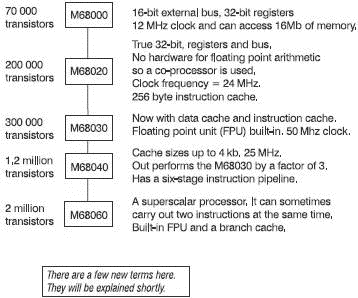Книга: Introduction to Microprocessors and Microcontrollers
Increasing the number of bits
Increasing the number of bits
It was inevitable that the 4-bit microprocessor that turned into the 8-bit should, in turn, grow into a 16-bit microprocessor but first a few moments to answer a seemingly obvious question.
What do we mean by a 16-bit microprocessor?
The ‘size’ of a microprocessor is the width of the data registers, so an 8-bit microprocessor can handle 8-bit numbers. It was traditional that 4-and 8-bit microprocessors had an address bus that was twice the width of the data registers. This was just a coincidence and doesn’t follow these days since no one wants, or could afford, the memory to fully use a 128-bit address bus (the number of locations is more than 3 followed by 38 zeros!)
The other fallacy is that it is necessarily the same as the width of the data bus. It is not. The Pentium family uses a 64-bit data bus but they have 32-bit data registers and are therefore 32-bit devices. It uses the 64-bit data bus to load two 32-bit registers at a time. The Power PC and the Digital Alpha family are real 64-bit devices and have a 128-bit data bus.
Curiously, the Intel 8088 was a real 16-bit microprocessor but had an 8-bit external data bus. This was to allow it to be compatible with the cheaper 8-bit circuitry, which had not quite caught up with the idea of using 16 bits.
Even so, the data registers are not universally accepted as defining the size of a microprocessor. Some people stick with the data bus to be the defining size. So, in reference books and catalogues you may find microprocessors referred to as a different ‘size’ to the one you expected. In this book I will stick with the data register as being the defining feature.
The 68000 family
The M68000, first produced in 1979 was a VLSI chip employing about 70 000 transistors. The M68000 microprocessor is well known as a 16-bit microprocessor but, in reality, it is a 32-bit device if we stick to our definition above. It certainly has a 16-bit data bus but the internal registers are 32-bit although some arithmetic operations can only use 16-bit data. Occasionally this format is called a 16/32-bit processor. It was in a 64 pin dil (dual-in-line) package, as shown in Figure 11.4, but even longer. Its length was often its undoing since it could easily snap in half if you attempted to remove it by prizing up one end of the chip. It has a 24-bit address bus that can therefore access 16 Mbytes of memory with a 12 MHz clock frequency.
One feature of M68000 is its pre-fetch action. When an instruction is being worked on, the microprocessor fetches the next instruction from memory and stores it in a little queue, ready to be used. This can be done whenever the present instruction is not using the external address and data buses. This means that the next instruction is already loaded ready to go as soon as it is required, thus saving valuable time. It has a total of seventeen 32-bit general-purpose registers of which eight are data registers, which can be used as 8-, 16-, or 32-bit registers as required.
One interesting feature is that this microprocessor can operate in two modes, supervisory and user. The essential difference is that the user mode has a restricted list of instructions at its disposal. The operating system can use the supervisory mode and thus use the full set of instructions but user programs only have access to a restricted range – enough to run the programs but, hopefully, not enough to screw things up too much. There is a software route between the two modes if you really want to change.
The M68000 gave rise to its own family as the basic model progressed. The main advances are detailed in Figure 11.8.

Figure 11.8 The M68000 family
As true 32-and 64-bit microprocessors have taken over the computing side, the 68000 family is used increasingly as a high-performance embedded control for printers and disk drives.
- Micros are getting bigger – and faster
- How do we measure the speed of a microprocessor?
- FLOPS (FLoating-point Operations Per Second)
- How to make a microprocessor go faster?
- Making more use of each clock pulse
- RISC and CISC
- Who did what, when
- The microcontroller
- Increasing the number of bits
- Where do we go from here?
- Games machines
- Quiz time 11
- 11. The development of microprocessors and microcontrollers
- Sequence number
- 4.4.4 The Dispatcher
- About the author
- Chapter 7. The state machine
- Appendix E. Other resources and links
- Example NAT machine in theory
- The final stage of our NAT machine
- Compiling the user-land applications
- The conntrack entries
- Untracked connections and the raw table
- Basics of the iptables command




